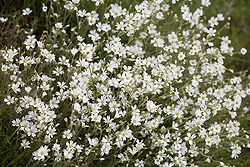Difference between revisions of "Cerastium arvense"
(→Taxonomy) |
(→Description) |
||
| Line 13: | Line 13: | ||
==Description== | ==Description== | ||
| + | General: Tufted perennial, often forming loose mats to 4 dm. broad, glabrous to glandular-pubescent, the flowering stems 5-50 cm. tall. | ||
| + | |||
| + | Leaves: Leaves opposite, linear to narrowly lanceolate, 1-nerved, 1-3 cm. long; cauline leaves often with bundles of secondary leaves in their axils. | ||
| + | |||
| + | Flowers: Flowers 3 to 5 or more in an open inflorescence; pedicels slender, erect, 1-3 cm. long; sepals 5, 4-6 mm. long, with stalked glands; petals 5, white, twice as long as the sepals, deeply bi-lobed-obcordate; stamens 10; styles 5. | ||
| + | Fruit: Capsule membranous, cylindric, slightly curved, 1.5 times as long as the sepals, opening by 10 teeth. | ||
| + | |||
==Bloom Period== | ==Bloom Period== | ||
==Distribution== | ==Distribution== | ||
Revision as of 07:45, 14 May 2012
Common name: Field chickweed
Abbreviation code: CEAR
Contents
Taxonomy
- Kingdom: Plantae
- (unranked): Angiosperms
- (unranked): Eudicots
- (unranked): Core eudicots
- Order: Caryophyllales
- Family: Caryophyllaceae
- Genus: Cerastium
- Species: C. arvense
Description
General: Tufted perennial, often forming loose mats to 4 dm. broad, glabrous to glandular-pubescent, the flowering stems 5-50 cm. tall.
Leaves: Leaves opposite, linear to narrowly lanceolate, 1-nerved, 1-3 cm. long; cauline leaves often with bundles of secondary leaves in their axils.
Flowers: Flowers 3 to 5 or more in an open inflorescence; pedicels slender, erect, 1-3 cm. long; sepals 5, 4-6 mm. long, with stalked glands; petals 5, white, twice as long as the sepals, deeply bi-lobed-obcordate; stamens 10; styles 5. Fruit: Capsule membranous, cylindric, slightly curved, 1.5 times as long as the sepals, opening by 10 teeth.
Bloom Period
Distribution
Habitat
Uses
Propagation
Seed
Seed sample from: 2011
Average Measurement: 0.9 x 0.9 x 0.5
Measurement Range: L: 0.75 – 1, W: 0.8 – 1, D: 0.4 – 0.6
Shape: Seed somewhat kidney shaped, narrower at hilum and broadening at opposite apex. Hilum pinched.
Color: Rusty brown to orange brown. Hilum white.
Surface: Matte and covered with many small bumps, arranged in concentric half circles originating at the hilum and broadening at the opposite apex.
Latitudinal Cross Section: elliptical ![]()
Longitudinal Cross Section: obovate ![]()
Basic Explanations and Assumptions:
The dimensions for the seeds are length x width x depth. The location of the hilum is used as the base of the seed, and the length is measured from hilum to the opposite apex. Where a style is present, the length is measured from the hilum to the bottom of the style. Width is measured at a right angle to the length at the widest part. Depth is measured at a right angle to the intersection of height and width lines.
Measurements included are the mean average for each measurement of ten separate seeds.
All measurements in millimeters unless otherwise noted.


